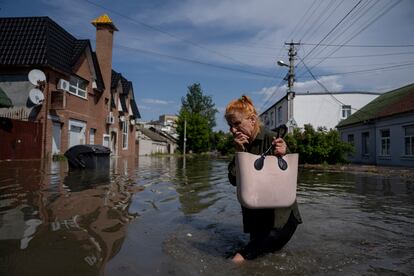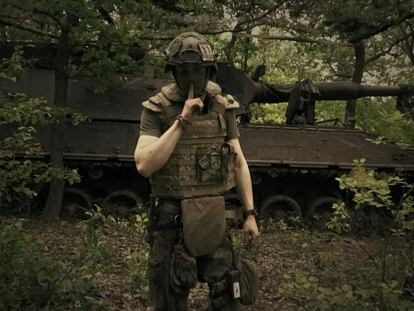Ukrainian dam breach: What is happening and what’s at stake
The dramatic rupture of the dam that upheld Ukraine’s largest reservoir released a torrent of water, raising fears of widespread damage and flooding in areas where tens of thousands of people live

The dramatic rupture of the dam that upheld Ukraine’s largest reservoir released a torrent of water Tuesday, raising fears of widespread damage and flooding in areas where tens of thousands of people live.
It’s not clear what caused the breach in the Kakhovka dam, which was already damaged by Russia’s war in Ukraine. The dam had held back the Dnipro River — a long stretch of which has become a front line — in a Russian-occupied area in the south.
Ukraine accused Russian forces of blowing up the facility, while Russian officials blamed Ukrainian military strikes.
Why is the dam so important?
The 30-meter-high (98-foot-high) dam and associated hydroelectric power station are located about 70 kilometers (44 miles) east of the city of Kherson — a flashpoint of the conflict in a region that Russia has claimed to have annexed but does not fully control.
Together with the power station, the dam helps provide electricity, irrigation and drinking water to a wide swath of southern Ukraine, including the Crimean Peninsula, which was illegally annexed by Russia in 2014.
Ukraine’s vast agricultural heartland, which is partially fed by the Dnipro River, is crucial to worldwide supplies of grain, sunflower oil and other foodstuffs. Global wheat and corn prices rose Tuesday on concerns that production might be disrupted.
The dam — one of the world’s biggest in terms of reservoir capacity — retained a volume of water nearly equivalent to that of the Great Salt Lake in the United States. The river waters supply cooling systems at the Zaporizhzhia nuclear power plant, where fighting has repeatedly raised fears of catastrophic accident.
What has happened to the dam during the war?
Russia has controlled the dam since the early days of the war, and Moscow and Kyiv have accused each other of shelling it. Ukraine said the troops occupying it detonated explosives last fall that damaged three sluice gates, which help regulate water levels. Signs of damage to the gates were evident in late May.
Even before the devastation wrought by Tuesday’s breach, hydropower generation was at a fraction of peak levels. Ukrainian officials and independent experts say Russian forces have failed to maintain the dam — built in the 1950s — either deliberately or through neglect.
Earlier this year, water levels in the reservoir were so low that many across Ukraine and beyond feared a meltdown at the Russian-occupied Zaporizhzhia nuclear power plant. Since mid-February, the water level has steadily increased, according to data from Theia, a French provider of geospatial analysis.
The Ukrainian company that manages the dam and power plant estimates that it will take about four days for the reservoir to reach equilibrium and stop discharging massive amounts of water.
Who and what is at risk?
As floodwaters swelled, both Russian and Ukrainian authorities ordered evacuations from among at least 80 towns and villages at risk on both sides of the river, though neither side reported any deaths.
Officials said about 22,000 people live in areas at risk of flooding in Russian-controlled areas, while 16,000 live in the most critical zone in Ukrainian-held territory.
U.N. Secretary-General Antonio Guterres said at least 16,000 people have already lost their homes, and the U.N’s humanitarian aid coordinator said efforts are underway to provide water, money, and legal and emotional support to those affected.
Ukraine’s Energy Ministry said there is a risk of flooding at energy facilities in the Kherson region. Nearly 12,000 consumers in the city of Kherson have already been left without electricity, and water supplies are also at risk.
Water levels dropped upstream. At the Zaporizhzhia nuclear plant, Europe’s largest, the Ukrainian operator and the U.N. atomic energy agency said there was no immediate risk to safety.
Experts warned about the possibility of an environmental disaster for wildlife and ecosystems — in Ukraine and beyond.
The biggest impact of the breach is likely to be upstream, said Mark Mulligan, a professor of physical and environmental geography at King’s College London and co-leader of the Global Dam Watch, a project that monitors dams and reservoirs.
“This huge reservoir is going to drain down, and the shallows upstream are going to dry out,” causing significant ecological damage to aquatic vegetation and wildlife that have relied on the water for seven decades, he said. The rapid flow of freshwater into the Black Sea could also damage fisheries and the wider ecology of the northwest part of the sea, he said.
What does it mean for the war?
Ukrainian officials said the Russians destroyed the dam to prevent Ukraine from launching a counteroffensive in the area, while Russian officials claimed that Ukraine destroyed the dam to prevent a potential Russian attack on the western bank.
Either way, the destruction of the dam severs a key crossing of the country’s most important river. The dam served as a bridge, enabling vehicles to pass over; its destruction also unleashed torrents of water, making it harder to cross the river by other means.
Since last fall, the lower portion of the Dnipro has made up an important part of the front line that stretches more than 1,000 kilometers (620 miles).
The crossing repeatedly came under rocket fire as Ukrainian forces led a successful counteroffensive in November that drove Russian forces back across the Dnipro.
Ukraine’s military has used groups of scouts to try to gain control of small islands near the Russia-controlled eastern bank and areas in the river’s delta. But experts say a broader offensive would involve major risks and logistical challenges.
Crossing the wide river was always seen as a daunting task for the Ukrainian military. Most observers expected it to launch a counteroffensive elsewhere.
Ukrainian military analyst Oleh Zhdanov said that the flooding would make crossing the river even more difficult, noting that it would impact the minefields on the Russia-controlled eastern bank. “Minefields were flooded, mines will be washed off and no one knows where they will surface,” he said.
Sign up for our weekly newsletter to get more English-language news coverage from EL PAÍS USA Edition
Tu suscripción se está usando en otro dispositivo
¿Quieres añadir otro usuario a tu suscripción?
Si continúas leyendo en este dispositivo, no se podrá leer en el otro.
FlechaTu suscripción se está usando en otro dispositivo y solo puedes acceder a EL PAÍS desde un dispositivo a la vez.
Si quieres compartir tu cuenta, cambia tu suscripción a la modalidad Premium, así podrás añadir otro usuario. Cada uno accederá con su propia cuenta de email, lo que os permitirá personalizar vuestra experiencia en EL PAÍS.
¿Tienes una suscripción de empresa? Accede aquí para contratar más cuentas.
En el caso de no saber quién está usando tu cuenta, te recomendamos cambiar tu contraseña aquí.
Si decides continuar compartiendo tu cuenta, este mensaje se mostrará en tu dispositivo y en el de la otra persona que está usando tu cuenta de forma indefinida, afectando a tu experiencia de lectura. Puedes consultar aquí los términos y condiciones de la suscripción digital.
More information
Archived In
Últimas noticias
Most viewed
- Reinhard Genzel, Nobel laureate in physics: ‘One-minute videos will never give you the truth’
- Oona Chaplin: ‘I told James Cameron that I was living in a treehouse and starting a permaculture project with a friend’
- Pablo Escobar’s hippos: A serious environmental problem, 40 years on
- Why we lost the habit of sleeping in two segments and how that changed our sense of time
- Charles Dubouloz, mountaineering star, retires at 36 with a farewell tour inspired by Walter Bonatti









































